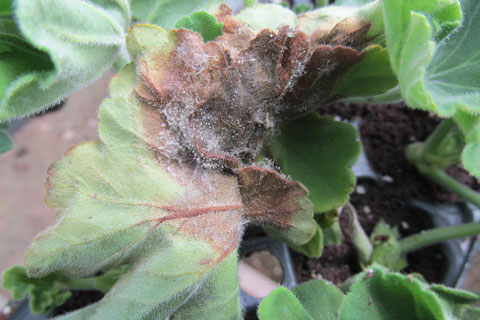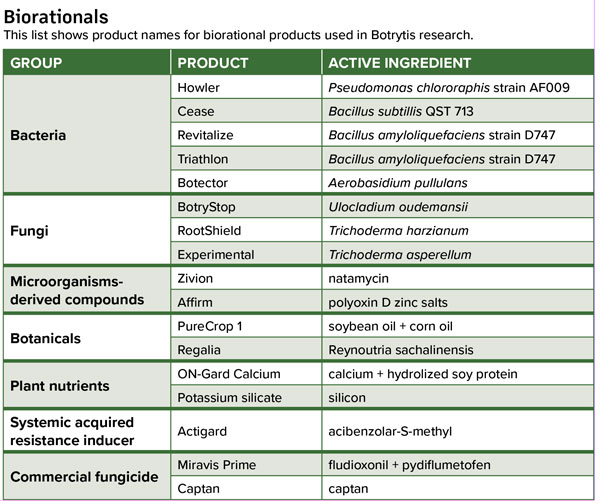11/1/2023
Control Botrytis Blight With Alternative Products
Julie Martens Forney

What’s your biggest headache as a grower? Thrips? Powdery mildew? Or how about everyone’s favorite, Botrytis? Add on labor challenges and shipping issues, and it’s a near-perfect recipe for every grower’s stress points.
There is good news, though: You’re not in it alone. Every issue you face, every problem you confront, you have an industry ally that’s ready to tackle these concerns head-on and come up with innovative solutions. That ally is the American Floral Endowment (AFE). For 62 years, the organization has taken grower problems to heart and funded research to create solutions. One of the latest issues AFE has sponsored is alternative Botrytis controls.
Botrytis resistance is legendary—and also the stuff of nightmares. When researchers like Dr. Jim Faust from Clemson University ship in roses from around the world to research Botrytis control methods, they find fungicide-resistant strains of the disease every time.
“There’s really some fungicide resistance everywhere in the world,” he said. “That means there’s only so much we can do with chemical fungicides to control this disease. The reality is, when you’re using chemicals for control, resistance builds up.”
Beating Botrytis with calcium
Because of the resistance issue, Jim and his team set a goal of finding alternatives to fungicides. Funded by AFE, their research explored options to control Botrytis that don’t induce resistance. From their early work, the team came up with using calcium as a treatment that’s integrated into existing Botrytis control programs.
 The calcium strengthens and stabilizes the cell wall in plant cells, which makes it tough for the Botrytis fungus to penetrate. The result? Delayed infection and symptom development.
The calcium strengthens and stabilizes the cell wall in plant cells, which makes it tough for the Botrytis fungus to penetrate. The result? Delayed infection and symptom development.
“Calcium has really been a success story in the industry,” Jim added. “It’s relatively inexpensive to apply and doesn’t cause resistance issues. Both U.S. and Colombian growers are using it effectively as a disease management tool.”
The success of calcium treatments “made us realize that one of the research goals needs to be finding alternatives to fungicides for Botrytis control,” Jim said. In this research, the goal is to develop non-conventional options for Botrytis control.
“Botrytis is quite good at circumventing the mode of action on a fungicide,” he said. “So the next logical step is looking at products that claim to have distinct effects on Botrytis.”
Here’s what his team has found.
Types of alternative products
There are all kinds of products that claim to have an effect on Botrytis.
“Some are biological organisms, like beneficial bacteria or fungi. Sometimes it’s a product where someone has grown Streptomyces, fermented it and obtained a chemical from it,” he explained. (The biological control agents are called BCAs for short.)
Natamycin falls into the BCA category, having been derived from fermented bacteria.
“It’s been used in the food industry since the 1950s. We’ve all regularly consumed it in cheeses and cured meats,” Jim said. “It has antifungal activity, but has never been used in plant production systems.”
Ultraviolet light renders natamycin inactive, so it’s not the best choice for anti-fungal use in plant growing. But for a postharvest treatment, it may have real value. Jim thinks it might have application with bedding plants like petunia that have Botrytis meltdowns during shipping.
“That’s one example of the types of products we tested for effectiveness against Botrytis,” he explained.
Over several years, the team tested up to 20 different compounds. “The vast majority offered no benefit,” Jim said.
 Some products, though, stimulated a plant’s natural defenses. They call those SAR inducers—systemic acquired resistance inducers. Basically, they’re compounds that activate a plant’s innate defenses. SAR inducers often take more time to demonstrate effective Botrytis control simply because it takes time to “turn up” the plant’s defenses.
Some products, though, stimulated a plant’s natural defenses. They call those SAR inducers—systemic acquired resistance inducers. Basically, they’re compounds that activate a plant’s innate defenses. SAR inducers often take more time to demonstrate effective Botrytis control simply because it takes time to “turn up” the plant’s defenses.
“What we noticed was that natamycin worked well against Botrytis infection on Day 1 of the treatment, while an SAR inducer-type product worked well on Day 7. It’s a much more complicated scenario, but allows a grower to be more strategic in the way they do treatments,” Jim said. “These results underscore the fact that this is a management situation and not a magic bullet for Botrytis control.”
Tank mixes work
With these results in hand, the next step was to test different tank mixes of the products. By taking two products with different strategies for preventing Botrytis infection, the results were “really encouraging—statistically the same as the best fungicide control that we used,” Jim said. “Some of these mixes look really promising.”
The tank mixes always include calcium “because we know that works,” said Jim, and then possibly a BCA and SAR inducer product. “Sometimes we do see an antagonistic effect by doing tank mixes (1+1 = 1.8) and sometimes we see a synergistic effect (1+1 = 3). It’s hard to predict and we really have to do the experiment to find the result.”
One concern the researchers have is whether or not a conventional fungicide will render the biorational alternative product inactive.
“Because of that concern, we use a much lower rate of fungicide,” Jim said. “The unwritten rule in fungicide management is that you don’t want to use a sub-lethal dose—that’s how you build resistance faster. We’re trying to answer that question now in our research. The thing is, if it works out well, we could end up using less chemical and getting the same efficacy by combining a conventional fungicide with a biorational product. So far, it’s looking pretty promising.”
Applying this research
Jim and his team have developed some recommendations for Botrytis management decisions:
■ When disease risk is high: Apply tank mixes of single- and multi-site fungicides.
■ When disease risk is low: Use a multi-site fungicide, a single-site fungicide or a biological control agent.
■ Spray calcium during production and use calcium showers or dips in postharvest applications.
■ Apply SAR inducers at regular intervals regardless of disease risk.
■ During off-peak season and low disease risk, rely on alternative measures.
For more information on this research, including product names for BCAs and SAR inducers, GO HERE. GT
You can find the results of all AFE-funded research free on the website (endowment.org) or plug into free monthly Grow-Pro webinars that present the latest information available to fine-tune your crop production skills. Webinars include live Q&A sessions. For a full list of upcoming webinars, visit endowment.org/webinars.
Julie Martens Forney is a freelance writer with more than 25 years of experience writing about floriculture industry issues and gardening for consumers. To read her current bylines, check out ASCFG’s Cut Flower Quarterly, SAF’s Floral Management and HGTV.com.